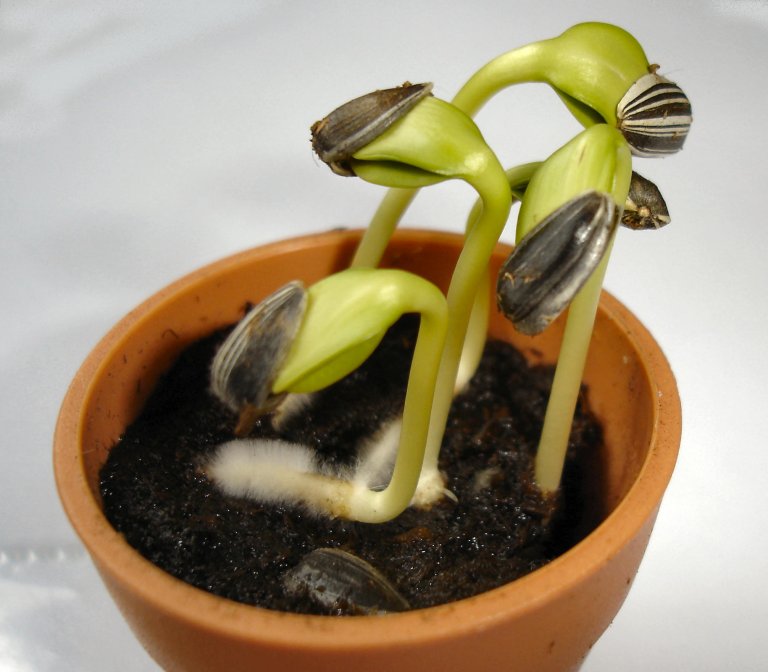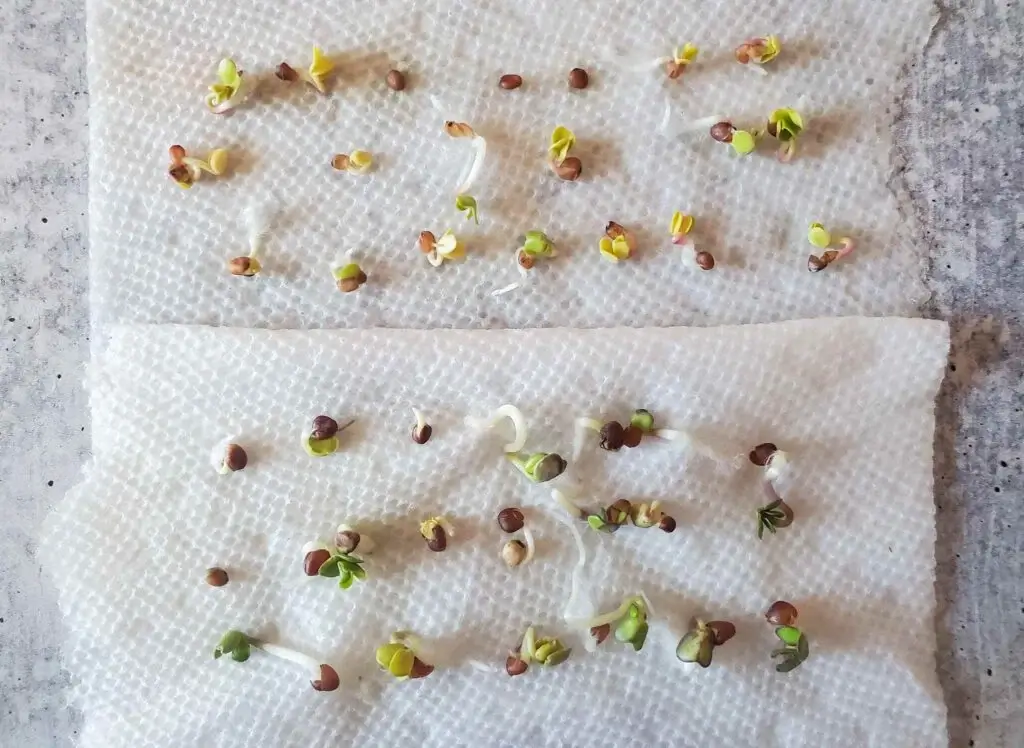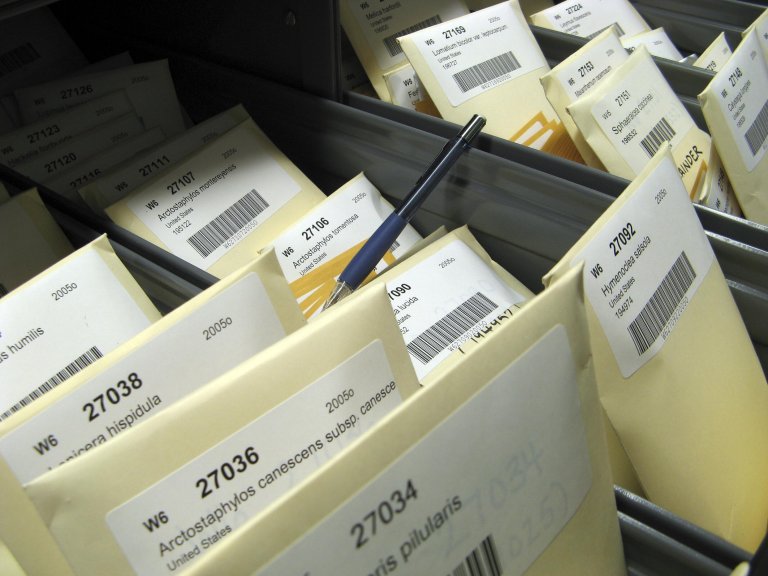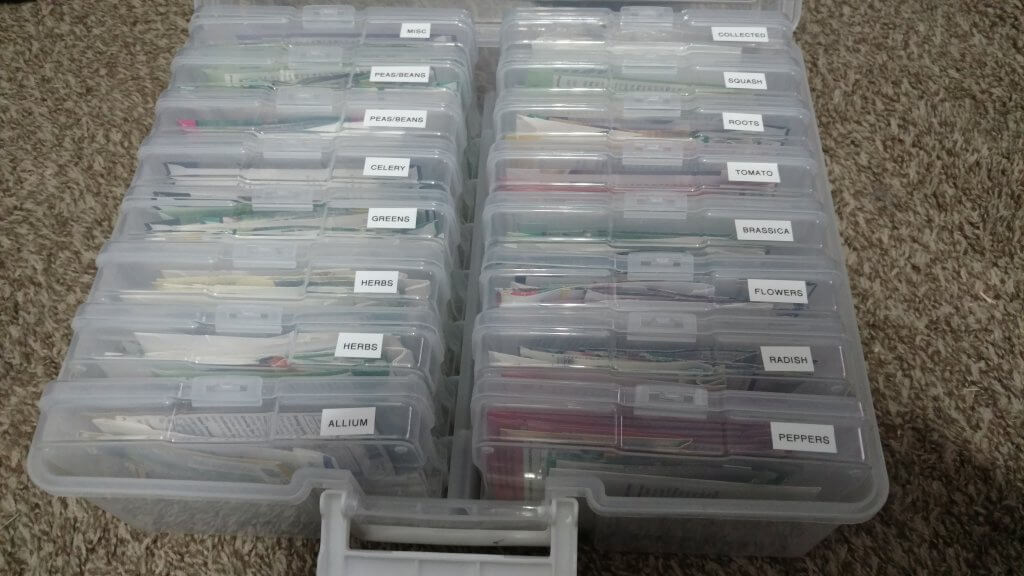After you’ve been gardening for a few years, one of things you have to start paying attention to is seed viability, or how long your seeds will last.
It is fairly common for most gardeners to purchase new seeds every year. Unless you’re a commercial gardener, you’ll rarely use all of them in a single season.
It’s important to know that seeds have a shelf life and that amount of time varies for the types of seed.
How Long Will Your Garden Seeds Last?
How long your seeds will last is never absolute. What you’ll find here are general guidelines, but personal experience can vary significantly based on the genetics involved and how they are stored.
Even if you use absolutely perfect seed storage and germination techniques, it’s entirely possible that some seeds won’t sprout. Conversely, sometimes even super fresh seeds won’t sprout, either.
It’s just a part of nature.

Another important thing to point out is most seeds don’t just “go bad” all at once.
Seed viability is about estimating a reasonable “shelf life” where you’ll still get decent germination.
Estimated Seed Viability Timeframes
Let’s get straight to the point. Below, you will find various common seeds and their estimated shelf life.
These estimates assume the seeds are well cared for in proper condition. See a little bit further on for seed storage tips.
Vegetable Seed Viability
Vegetable Seed Viability
| Vegetable Seed: | Seed Viability: |
|---|---|
| Artichokes | 5 years |
| Arugula | 3 years |
| Barley | 5 years+ |
| Beans | 3 years |
| Beets | 4 years |
| Broccoli | 4-5 years |
| Brussels Sprouts | 4-5 years |
| Buckwheat | 5 years+ |
| Cabbage | 4-5 years |
| Carrots | 3 years |
| Cauliflower | 4 years |
| Celery/Celeriac | 5-6 years |
| Chard (Swiss) | 4 years |
| Collards | 5 years |
| Corn | 1-2 years |
| Cress (Watercress) | 5 years |
| Cucumbers | 5-7 years |
| Eggplant | 4-5 years |
| Endive/Escarole | 5 years |
| Kale | 4-5 years |
| Kohlrabi | 4-5 years |
| Leeks | 1-2 years |
| Lettuce | 5-6 years |
| Melons | 5 years |
| Mustard | 4 years |
| Oats | 5 years+ |
| Okra | 2 years |
| Onions | 1-2 years |
| Parsnip | 1 year |
| Peas | 3 years |
| Peppers | 2-5 years |
| Pumpkins | 5-7 years |
| Quinoa | 5 years+ |
| Radish | 4-5 years |
| Rutabagas | 4 years |
| Rye | 5 years+ |
| Sorghum | 4 years |
| Spinach | 2-3 years |
| Summer Squash | 4 years |
| Tomatillo | 3 years |
| Tomato | 4 years |
| Turnip | 5 years |
| Watermelons | 4 years |
| Wheat | 5 years+ |
| Winter Squash | 4 years |
Herb Seed Viability
Herb Seed Viability
| Herb: | Seed Viability: |
|---|---|
| Basil | 3-5 years |
| Chamomile | 3 years |
| Chives | 1-2 years |
| Cilantro/Coriander | 5 years |
| Dill | 5 years |
| Fennel | 3-4 years |
| Marjoram | 2-3 years |
| Mint | 2-4 years |
| Oregano | 1-2 years |
| Parsley | 1-3 years |
| Sage | 2 years |
| Stevia | 1 year |
Flower Seed Viability
Flower Seed Viability
| Flower Seed: | Seed Viability: |
|---|---|
| Ageratum | 4 years |
| Amaranthus | 4-5 years |
| Anthemis | 2 years |
| Anthirrhium | 3-4 years |
| Calendula | 5-6 years |
| Celosia | 4 years |
| Cineraria | 3-4 years |
| Clarkia | 2-3 years |
| Cosmos | 3-4 years |
| Digitalis | 2 years |
| Eschscholzia | 3 years |
| Gaillardia | 2-3 years |
| Godetia | 3 years |
| Helianthus | 2-3 years |
| Heliotrope | 1-2 years |
| Hollyhock | 2-3 years |
| Impatiens | 2 years |
| Larkspur | 1-2 years |
| Linaria | 3 years |
| Linum | 1-2 years |
| Lobelia | 4 years |
| Marigold | 2-3 years |
| Nasturtium | 5-7 years |
| Nicotiana | 4-5 years |
| Nigella | 2 years |
| Pansy | 2 years |
| Petunia | 2-3 years |
| Phlox | 2 years |
| Salvia | 1 year |
| Schizanthus | 4-5 years |
| Sunflower | 5 years |
| Sweet peas | 2-3 years |
| Sweet William | 2 years |
| Viola | 1-3 years |
| Wallflower | 4-5 years |
| Zinnia | 5-6 years |
The Law & Garden Seed Viability
Way back, many years ago, seed viability was a problem. There was no “standard” to hold anyone to.
Someone could sell you seeds that were all ready old, or would fail to germinate in a meaningful way. This was a major issue as seeds are a major foundation of food security. A lack of any kind of standard puts that at risk.
In the United States, at least, a lot of states have drafted laws that determine certain rates of seed viability. If particular seeds fall under those limitations, they must be properly identified as such.
This article isn’t a thorough deep dive into state laws and those requirements. They are complex, vary from state to state as well as plant to plant. The point is really just to make the reader aware of this practice.
Beyond that, most places where you’d buy seeds have a motivation to sell you good seeds. They want you to be a return customer, which comes from being happy with your original purchase.
Therefore, unless stated otherwise, you can generally expect most seeds you purchase to have at least 75% germination rates. That means, in theory, 3 out of 4 seeds will grow into a plant. (The quality of those plants and specific genetic factors are a different story, however…)
Testing Garden Seed Viability
If you’re not sure whether your seeds are still good, there is a way to find out. There is a very easy test for determining whether your seeds are still good.
You can just plant them, of course, but if you get low germination then you might not get as many plants as you need.
The easiest way to test seed viability is using the paper towel method:
- Take a single paper towel and fold it in half two to three times and then moisten the towel with tap water.
- In between the flaps of the paper towel, sprinkle five to ten seeds.
- Close the paper towel flap and place the folded paper towel inside of a Ziplock plastic bag, zipping the bag up to retain moisture.
- You can place the bag virtually anywhere. In almost all cases, it doesn’t need direct light or artificial lighting to germinate. Try to choose an area that is around 70 to 80 degrees Fahrenheit.

Wait for the initial germination time to expire, typically a few days to a week. Then, check the seeds to see if you see any sprouts. If you do, great, your seeds are still viable!
If not, fold the paper towel back up, insert into the bag and zip it back up again. Check your seeds every couple days for sprouting.
If you haven’t seen a sprout by the maximum germination time, chances are good your seeds are no longer viable and should not be planted. Time to buy more seeds!
Also, you’ll want to do this ahead of your typical planting schedule, since it can take some time for the seeds to germinate.
Determining Your Seed Viability Percentage
If you use the above method, you can calculate your seed viability percentage. This will help you see “how close” you are to the original “guaranteed” germination rates. Again, a rough guideline is about 75% germination rates for newly purchased seeds unless stated otherwise.
You can use the following formula to determine your seed viability percentage:
- Number of seeds germinated / Number of seeds tested
- Multiply the above result by 100 (or just use the results, assuming you’re familiar with calculating percentages)
The above will give you a fairly accurate picture of the percentage of seeds that will still germinate.
This data can also be used to help the gardener “guesstimate” how many seeds they need to plant to get one plant.
For example, if your seeds are only 20% viable, you will need to plant five seeds to have a relative assurance you will get a plant from those seeds.
How To Best Store Your Garden Seeds
Seed storage techniques play a huge factor in determining how long your seeds will last.
It’s a good idea when you buy seeds to clearly mark the year that you purchased the seeds on the packet. Not all seed packets have this information on them.
Some packets are marked with a “sell by” date, and this is usually the year you buy them. This isn’t a consistent practice from seed vendors, so we just mark the year when we receive them.
 There are many techniques available for storing your seeds from season to season.
There are many techniques available for storing your seeds from season to season.
Dry and cool is the golden rule.
Generally speaking, you want to keep the seeds in their original packets, or an envelope if you don’t have a packet. These packets and envelopes should be placed inside another container, preferably as airtight as possible.
We really like using a photo organizer for storing our garden seeds, as shown below. The individual containers are labeled to allow easy identification and organization of our entire seed bank.
We use a photo storage container for storing our seed bank. It’s been one of the best investments we’ve made into seed storage. We have one for vegetables and one for flowers.
Keep the seeds in a cool place, but not freezing, and they should last for the expected amount of time.
We don’t do anything special, we just keep them in the house somewhere. Generally, our home is kept between 60 and 70 degrees most of the time.
Some people store seeds in their refrigerator. This can work, but our fridge space is pretty valuable and not for seed storage.
If you do this, make sure your storage container is airtight (with a seal) so when you take the seeds out, you’re not subjecting the seeds to moisture as they warm up. Try to avoid storing the seeds where the refrigerator vents from the freezer
Also never store seeds in your freezer! There are some exceptions when it comes to seed stratification, but overall avoid the freezer. These exceptions are highly plant specific and are designed to help the seed “experience” a simulated winter.
If you’re collecting your own seed from your garden, it will be important to make sure you’ve removed all moisture from the seeds prior to storage. You can place the seeds on a paper towel and allow them to air dry for some time prior to storage.
Once dry, simply place them into an envelope and then your storage container.
What To Do If You Have “Old” Seeds?
As mentioned above, most seeds don’t just all of sudden stop working. The viability of seeds will degrade over time.
If you have seeds that have exceeded their viability life span, you can likely still plant them and get great garden starts. Simply increase the numbers of seeds that you plant in each cell or plant more cells.
Our typical seeding rates, with seeds in good condition, is around 1-3 seeds per cell, depending on the plant. If we’re increasing that, we might look at 2-6 seeds per cell. Sometimes even more.
If you get really bad germination rates, you might have to use a lot more. You can use the seed viability test above to get you in the ballpark of where this should be.
Planting more seeds will help ensure that you will still get a plant, in the event several seeds don’t pop.
Some seeds, such as onion seed, are truly limited in how long they will last. For example, most allium seeds are only good for one year. You might be able to get two years, but you’ll start experiencing higher failure rates.
That’s All We Wrote!

Having a good time? We have an ever growing list of insightful and helpful subarctic & cold climate gardening articles, waiting out there for you!
- Cold Climate Gardening Basics 👉
- Growing Your Garden From Seed Indoors 👉
- Advanced Cold Climate Gardening Techniques 👉
- Plant Specific Cold Climate Growing Guides 👉
- Subarctic Perennial Food Forests & Foraging 👉
- Indoor Garden Lighting & Grow Rooms 👉
- Greenhouses & Temperature Control 👉
- Harvesting & Food Preservation 👉
- Solving Cold Climate Garden Problems 👉
- 1 Minute Reads On Tons Of Garden Topics 👉
FrostyGarden.com is 100% ad-free and we do not use affiliate links! This resource is voluntarily supported by our readers. (Like YOU!) If we provided you value, would you consider supporting us?

